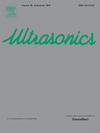两种次谐波辅助压力估计(SHAPE)分析方法的比较评价
IF 4.1
2区 物理与天体物理
Q1 ACOUSTICS
引用次数: 0
摘要
在临床实践中,压力测量是一种有价值的诊断评估工具,特别是在门脉高压等疾病中。目前,门静脉压力是通过侵入性肝静脉导管测量的,这给患者带来了风险,并且限制了测量的频率。亚谐波辅助压力估计(SHAPE)是一种基于超声的技术,利用超声造影剂(UCAs)来估计静水压力的变化。当暴露在足够高的声压(通常为200千帕)下时,uca充当非线性振荡器,并产生从次谐波到高谐波的显著能量分量。组织不会产生显著的次谐波成分,因此使其成为SHAPE的最佳成分。SHAPE是通过亚谐波成像和声压优化算法来实现的,从而使uca对静水压力具有最高的灵敏度。传统上,通过多次采集对比片段来识别次谐波幅度并计算SHAPE参数,但最近提出了一种更快的SHAPE方法,仅利用声压优化算法来获取次谐波幅度。本研究的目的是比较SHAPE和fast-SHAPE两种方法在同一患者中的应用,探讨fast-SHAPE的实用性。本文章由计算机程序翻译,如有差异,请以英文原文为准。
A comparative evaluation of two subharmonic-aided pressure estimation (SHAPE) analysis methods
Pressure measurement in clinical practice is a valuable tool for diagnostic evaluation, especially in diseases such as portal hypertension. Currently, portal pressures are measured by invasive hepatic vein catheterization, posing risks to patients, and limiting how often measurements can be obtained. Subharmonic-aided pressure estimation (SHAPE) is an ultrasound-based technique that leverages ultrasound contrast agents (UCAs) to estimate changes in hydrostatic pressure. UCAs act as nonlinear oscillators when exposed to high enough acoustic pressures (typically > 200 kPa) and produce significant energy components ranging from subharmonics to higher harmonics. Tissues do not generate significant subharmonic components, thus making it the optimal component for SHAPE. SHAPE is performed using subharmonic imaging complimented by an acoustic pressure optimization algorithm to induce the highest sensitivity to hydrostatic pressure in the UCAs. Traditionally, multiple acquisitions of contrast clips are used to identify the subharmonic amplitude and calculate SHAPE parameters, but recently, a faster method of SHAPE has been proposed, utilizing only the acoustic pressure optimization algorithm to obtain subharmonic amplitudes. The objective of this work is to compare the two methods, SHAPE and fast-SHAPE, in the same patients, to explore the utility of fast-SHAPE.
求助全文
通过发布文献求助,成功后即可免费获取论文全文。
去求助
来源期刊

Ultrasonics
医学-核医学
CiteScore
7.60
自引率
19.00%
发文量
186
审稿时长
3.9 months
期刊介绍:
Ultrasonics is the only internationally established journal which covers the entire field of ultrasound research and technology and all its many applications. Ultrasonics contains a variety of sections to keep readers fully informed and up-to-date on the whole spectrum of research and development throughout the world. Ultrasonics publishes papers of exceptional quality and of relevance to both academia and industry. Manuscripts in which ultrasonics is a central issue and not simply an incidental tool or minor issue, are welcomed.
As well as top quality original research papers and review articles by world renowned experts, Ultrasonics also regularly features short communications, a calendar of forthcoming events and special issues dedicated to topical subjects.
 求助内容:
求助内容: 应助结果提醒方式:
应助结果提醒方式:


